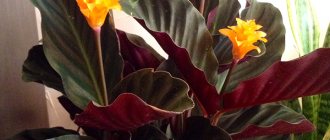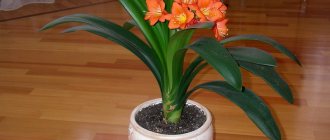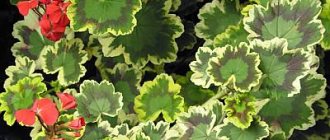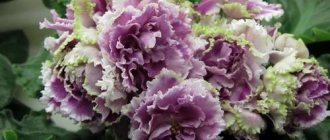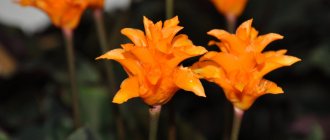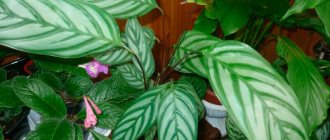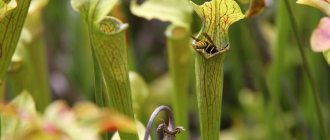Calathea rufibarba is a perennial evergreen plant from the arrowroot family, native to distant South America. This flower does not have a stem as such; lanceolate leaves with ribbed edges grow on large petioles. On the outside they are smooth, delicate emerald color, the inner surface is burgundy or dark cherry. When calathea begins to bloom, the inflorescences are small and white-yellow.
Structural features
Calathea is a herbaceous shrub that belongs to the arrowroot family. This plant is native to the forests of Central and South America. The name calathea is translated from Greek as basket. This is due to the fact that baskets were woven from the leaves of some types of calathea. Calathea has no stem; large oval or oval-oblong leaves are located on high petioles.
The height of the plant can reach 85-90 cm.
The color of the leaves depends on the calathea variety, and the designs and patterns on the leaf plate can also be different. The root system consists of a large number of small roots.
The peculiarity of this variety is that:
- The petioles of the plant and the lower part of the leaf are covered with a small fluff, colored red. The bush is medium in size and dense if properly cared for.
- The oblong oval leaves, wavy at the edges, are located on high petioles.
- The upper part of the leaf blade has a pattern that consists of light green and dark green. The lower part is painted in a burgundy-violet tone.
- During the daytime, the leaves are positioned horizontally; at night, they rise and fold toward each other like palms.
Description of the plant
Calathea rufibarba, or as it is also called “velvet calathea or redbeard calathea,” is a plant from the family Marantaceae, native to Brazil. The plant's common name translates to downy feather or velvet, referring to the fuzzy, fur-like structure of the lower part of the leaf, which is unusual in its own way.
The height and diameter of the Calathea Rufibarba bush rarely exceeds 55-65 cm, but sometimes you can find specimens up to 70 cm high on sale. The leaves grow on thick short petioles. At first glance they seem smooth and glossy, but if you look closely it becomes clear that their surface is velvety. The leaf blades are lanceolate, long, thin, with clearly defined veins, a wavy edge and corrugated surface, dark green upper and burgundy lower sides, covered with light reddish fibers. Under natural conditions, red-bearded calathea blooms with small, pale yellow, spike-shaped inflorescences. In culture, flowering occurs extremely rarely and reluctantly.
You can buy calathea for your home by following this link.
Several hybrids have been bred based on Calathea Redbeard. The most popular of them is Calathea rufibarba 'BlueGrass', bluegrass. Its main difference from the mother species is the dark green color of the leaves, both on the upper and lower sides.
Furry Feather (Calathea rufibarba)
Care
Calathea rufibarba is one of those plants that develop well and grow in partial shade. Direct sunlight and intense lighting have a detrimental effect on the plant; burns may appear on the leaves and their edges begin to dry out. Western or eastern windows are perfect for placing a pot with a plant. Calathea can also grow under artificial light, provided there is 16 hours of light per day.
For calathea, the acceptable temperature range is between 20-22 degrees Celsius.
But in the summer, it feels normal even at 30 degrees Celsius, and intensive humidification of the air in the room is recommended. In winter, in the room where the plant is located, the air temperature should not drop below 18 degrees. If the tubers are overcooled for a long time, the plant will die. Calathea does not tolerate sudden changes in temperature and changes in its permanent place of growth.
Watering the plant:
- In summer, calathea is watered regularly; overwatering and waterlogging the soil is not recommended, as the roots quickly rot and the plant dies. But you can’t overdry the calathea either.
- To select the optimal watering time, it is recommended to monitor the soil when it dries out by 1-2 cm - you can water again. To do this, it is recommended to use soft water at room temperature, standing for 1-2 days.
- In winter, when the plant is dormant, it is recommended to water 2 days after the top layer of soil has dried.
Since Calathea rufibarba is a tropical plant, it is susceptible to air humidity. It is recommended to install a humidifier in the room where the plant is located or daily spray the space around the plant with a fine spray bottle of settled soft water at room temperature. Calathea of this variety does not tolerate water on the leaves. During the heating season, the pot with the plant can be placed on a tray with expanded clay or wet sand with water. Water is periodically poured into the pan.
Every year in the spring and the first part of summer it is necessary to apply fertilizers to the soil.
For this purpose, complex fertilizing for decorative foliage plants is used. This event is held once every 2 weeks. Calathea does not tolerate an excess of nutrients; it may lose the bright color of its leaves or get sick. Therefore, the dosage and frequency of fertilizer application are strictly according to the rules.
Calathea does not need pruning. It is periodically necessary to remove old and fading leaves to preserve the decorative appearance of the plant.
Description of Brazilian Calathea
Under natural conditions, Calathea rufibarba grows in the tropical forests of Brazil. It belongs to the arrowroot family. The perennial plant is formed in the form of a small bush, the height of which reaches 60-70 cm in height. The surface of the leaves is ribbed and shiny. Many subspecies of Calathea rufibarba have visible veins and streaks on the leaves.
As for the root system of the flower, it is small and poorly developed. Therefore, when planting, you need to carefully select the appropriate soil composition, enriched with minerals and nutrients. Otherwise, the calathea will not have enough nutrition, the leaves will fade and become lethargic.
Growing in the tropics, the Brazilian beauty is accustomed to constant high humidity and long daylight hours. At home, you will have to provide the same growth conditions, and this is not always easy to do. But if you care for it correctly, the bush will be thick and lush. It is noteworthy that a reddish-colored fluff appears on the petioles, and sometimes on the underside of the leaves. During the day, the leaves are straightened and arranged horizontally, and at night the calathea collects and folds them.
Transfer
Calathea rufibarba grows well with proper care. The young plant is replanted annually in the spring and each time the size of the pot is slightly increased. Adult bushes are transferred to new pots once every 2 years.
The substrate for replanting can be bought in stores, specially designed for planting arrowroot.
You can also make it yourself by mixing peat, calcined river sand, turf soil and coniferous tree soil in equal parts. The substrate should be loose and breathable. You can also add some charcoal. A thick layer of drainage must be laid out at the bottom of the pot.
3. Varieties of Calathea:
3.1.Calathea Crocata or saffron - Calathea Crocata
An evergreen compact plant that features both attractive foliage and beautiful blooms. It originates from tropical regions, including Brazil. Forms a rosette of basal leaves on long petioles. The leaf blades are oblong-oval, with a dark green, matte, corrugated surface. The lower surface of the leaves is painted in a contrasting violet-burgundy shade. During the flowering period, calathea throws out peduncles that rise slightly above the leaves. At the top of the flower stalks are bright yellow or orange flowers with large, colorful bracts. The flowering period is long and can last 2 - 3 months.
↑ Up,
3.2. Calathea Veitch Medallion or Roseopicta - Calathea Roseopicta
A magnificent decorative foliage plant with large, rounded leaves with a characteristic pattern. Leaves are basal, on high petioles. There are plants with both green and purple leaves. The leaf blades are corrugated, glossy, with a contrasting burgundy colored underside. In summer, Calathea Medallion may produce flower stalks with small white or lilac flowers, which often go unnoticed against the backdrop of colorful foliage.
↑ Up,
3.3. Calathea warscewiczii
This species can be classified as both decorative foliage and flowering plants. Calathea Varshevich has large velvety green leaves with a characteristic pattern. The leaf petioles are long and thin. The underside of the leaf blades has a purple tint. In addition to attractive leaves, the bushes form spectacular cone-shaped inflorescences. The bracts are creamy white, but over time they turn yellow and then take on a pinkish tint. They are arranged in a spiral around the inflorescences, making them look like a rose flower when viewed from above. The flowering period lasts 3 - 4 weeks.
↑ Up,
3.4. Calathea Lancifolia
Widespread in indoor culture are decorative foliage plants with long (up to 70 cm) sword-shaped leaves on short petioles. The leaf blades are glossy, with a wavy edge, elegantly corrugated, light green with oval dark spots. The underside of the leaf blades is purple or burgundy. Flowering is not of particular interest and rarely occurs at home.
This species is often kept indoors, as it has minimal maintenance requirements - it tolerates growing in shade and forgives many mistakes in care.
↑ Up,
3.5.Calathea rufibarba or red-bearded - Calathea rufibarba
An evergreen ornamental foliage plant with long sword-shaped green leaves. The leaf blades are corrugated, glossy, colored burgundy on the underside, and have slight pubescence. The leaf petioles are long, thin, burgundy, covered with sparse pubescence. The variety is tall - can reach 60 - 90 cm in height. During the flowering period, small yellow flowers with bright bracts are located at the base of the leaves.
↑ Up,
3.6. Calathea makoyana - Calathea makoyana
A bright decorative foliage representative of the genus, it belongs to the compact varieties. The leaf blades are oblong-oval, pointed, light green in color with a glossy surface and dark oval spots of different sizes, the length of the leaves reaches 30 cm. The lower surface of the leaves is pinkish or burgundy. In summer the plant often produces small white flowers, but they are not particularly interesting.
↑ Up,
3.7. Decorated calathea - Calathea ornata
In fact, there are currently three plant species classified in this phylum - Calathea sanderiana, Calathea majestica and Calathea regalis. All species are distinguished by attractive large leaves with beautiful geometrically regular patterns on the surface of the leaf blades.
↑ Up,
3.8.Calathea sanderiana - Calathea ornata sanderiana
An evergreen ornamental deciduous plant with large oval leaves of a dark green color. The leaf blades are glossy, entire, with thin yellow or pink stripes radiating from the central vein. The underside of each leaf is burgundy or red. The flowers rarely appear at home and are white or purple in color with yellow-orange bracts arranged in a spiral.
↑ Up,
3.9. Calathea Orbifolia or round-leaved - Calathea orbifolia
A plant with large leaves and long petioles. The leaf blades are entire, glossy, painted in alternating light and dark green stripes diverging from the central vein. The lower surface of the leaf blades has a lighter green tint. The plant, even when grown indoors, can exceed 1 m in height, but develops slowly.
The variety is unpretentious and is suitable for growing by beginning gardeners.
↑ Up,
3.10. Calathea bachemiana
Ornamental plants with hard, long, sword-shaped leaves on short petioles. The leaf blades are entire, painted in a light silvery-green tint. The central vein is expressed in a darker color and has diverging dark narrow stripes. The lower surface of the leaves can be either green or burgundy. Flowering is not particularly attractive and often goes unnoticed. After flowering, the plant may lose the entire above-ground part - it will die, but then the plant produces new young shoots.
↑ Up,
3.11.Calathea Lubbersii - Calathea Lubbersii
A low evergreen plant with oval, glossy leaves on tall petioles. The leaf blades are colored emerald green and have asymmetrical large greenish or yellow stripes.
↑ Up,
3.12. Calathea lietzei
A perennial ornamental foliage plant with long, glossy, lanceolate leaves on thin, often drooping petioles. The leaf blades are entire, dark green, with light green stripes radiating from the central vein. The edges of the sheet plates are corrugated. In the warm months, each bush is capable of forming several strong, erect flower stalks, which bear small inflorescences with delicate, pinkish flowers at the tops.
This variety does well at home, as it does not require very high air humidity and can withstand the accumulation of salts in the soil.
↑ Up,
3.13.Lanceolate or wonderful Calathea lancifolia
A spectacular evergreen perennial up to 70 cm high. The main decoration of this plant is its bright, narrowly lanceolate leaves. The leaf blades are light green, with dark, elliptical spots, reaching a length of 45 cm. The lower surface of the leaves is painted in a contrasting burgundy shade.
↑ Up,
3.14. Wavy Calathea - Calathea undulata
Attractive small perennials with oblong, elliptical, basal leaves. The leaf blades are entire, slightly corrugated, and colored in an emerald green hue. Along the central vein on the leaves there is a light, wide, green stripe.
↑ Up,
3.15. Calathea majestica
Large-leaved, shade-tolerant variety with oblong, oval leaves on thin petioles. The leaf blades are oval, glossy, dark green, with thin and very light, diverging strokes on the surface. The lower surface of the leaves is burgundy. Low peduncles bear small orange flowers at the top. With age, this species can reach an impressive size.
↑ Up,
3.16.Calathea Louise - Calathea louisae
Large variety - plants reach 80 cm in height and have oblong, oval leaves on thin, long petioles. The leaf blades are emerald green with slight light stripes radiating from the central vein, corrugated, glossy, entire. The lower surface of the leaves has a burgundy or deep purple hue. Short flower stalks form in the center of the plant, often remaining hidden by the foliage. The flowers are small and cream-colored.
↑ Up,
3.17. Zebra-shaped calathea - Calathea zebrina
Tall, decorative-leaved perennials up to 1 m high. The leaves are narrow, lanceolate, on strong, slightly curved, ribbed petioles. The leaf blades are green, with dark, narrow stripes on the surface. On the underside, the leaves are colored in a lighter or burgundy shade. The length of the leaf blades reaches 60 cm. The flowers are collected in small inflorescences on the tops of short peduncles and often go unnoticed under the foliage.
↑ Up,
Reproduction
Calathea rufibarba can be propagated by dividing the bush or by seed. The bush is divided during spring replanting. For this:
- The bush is watered well during the day so that the root system can easily come out of the pot. Only adult bushes that have managed to grow a powerful root system or tubers are suitable for this method of propagation.
- One calathea can be divided into 3-5 new bushes.
- Division is done carefully so that damage to the roots is minimal.
- At the same time, the entire plant is examined for the presence of rotten or dried parts, which are removed using sharp scissors or a knife.
- Each new plant should have at least 3-4 healthy leaves.
- Plants are planted in a fresh substrate; it is recommended to add most of the peat to it first.
- After planting, the soil is watered with warm heated water and left until dry. After that, watering is carried out according to the usual system.
- Pots with young bushes are placed in a warm place.
- When new leaves are visible on the calathea, this is a sign that it has taken root and can be transferred to a pot with a regular arrowroot substrate.
- Transshipment is carried out carefully so as not to damage the root system and planted in a pot along with a lump of earth.
Propagating calathea using seeds is a longer process. To do this, you first need to prepare a substrate, which consists of equal parts of peat and river sand. Peat can be replaced with leaf soil. The seeds are carefully placed into the container from the substrates, and a greenhouse needs to be made on top.
The temperature in the room where the seedlings are germinated should be between 22-25 degrees Celsius.
The crops are periodically moistened with a spray bottle. They are also placed in shade from the sun, but not in the shade. The first picking is carried out when 2 adult leaves appear on the sprouts. They are transferred in small groups to containers with the same soil. Care and watering continue in the same mode. When the seedlings grow, they are planted in separate small pots for further cultivation.
The propagation method using seeds is not popular among amateur gardeners; it is mainly used in botanical gardens and greenhouses. Often purchased seeds do not have the promised germination rate and seed hatching percentage.
Plant diseases and pests
The parasites that calathea can acquire are similar to many other house plants. These are spider mites, scale insects, thrips and mealybugs. They often affect a flower if it is weakened or develops in unsuitable conditions. It is important to detect the problem early and use the appropriate fungicides to get rid of the pests.
As for diseases and developmental disorders of calathea, you most often encounter the following manifestations:
- Rotting and falling of leaves is associated with excessive soil moisture;
- Dried and curled leaves appear if the air is too dry;
- Spots and burns on the leaves indicate excessive sunlight;
- If new leaves do not appear for a long time, the growth of the plant is slowed down, this is a sign of a lack of minerals and vitamins.
Caring for calathea includes many rules and features, but doing them at home is quite possible if you want. As a result, the bush will be lush, the leaves will be smooth and rich in color, and in the summer the plant will delight you with beautiful delicate blooms.
Home care
Calathea rufibarba is a demanding and whimsical plant that requires the most careful attention, therefore it is not recommended for inexperienced gardeners to breed it.
Care at home does not take much time, but this capricious flower constantly needs to maintain the required temperature, humidity and lighting.
Temperature and lighting
The plant feels good at standard room temperature - +19-24 degrees. In the hot season, it will tolerate higher temperatures - up to +30 degrees. The main thing is to provide the flower with regular watering and moisture.
The optimal lighting for Calathea rufibarba is partial shade. Both exposure to direct sunlight and constant stay in a shaded place are harmful to her.
Watering and air humidity
The root system of the plant is superficial, so it is necessary to carefully ensure that the top layer of soil is constantly moistened. Both lack and excess of moisture are equally harmful to this flower. It prefers high humidity conditions: approximately 85-90%, so it requires regular misting. The plant should be irrigated twice a day.
Soil and fertilizers
The flower needs loose soil that allows water to pass through well and consists of humus, peat and sand. In terms of chemical composition, it should be slightly acidic. You can purchase special soil for Saintpaulias or plants of the arrowroot family in the store. Before planting, you need to put a layer of drainage on the bottom of the container.
Fertilizers should be applied regularly. You can’t be zealous or forget about it. Calathea rufibarba does not tolerate either excessive feeding or lack thereof. Fertilizers must be applied once every two weeks, diluting them in water for irrigation. The concentration of fertilizing should not be high; you need to dilute half of the dose indicated in the instructions.
The pot for the flower should be selected taking into account the fact that its root system is poorly developed and does not go deep into the ground. That is, the container should be wide and not very deep.
Transplantation and propagation
It is recommended to transplant young flowers once a year, in the spring. Adult plants are replanted as needed when the roots become crowded in the pot.
The most preferred method of propagation is division of roots. This is done during the next transplant. Small pieces with a sufficient number of leaves are separated from the plant and replanted in well-fertilized and moist soil. Such young plants require even more careful care than adult flowers.
Reproduction of Calathea rufibarba
Calathea propagation occurs by dividing the bush during transplantation. The root system is carefully and carefully divided into smaller parts, which are planted as individual plants. Each of the newly created bushes should have a rosette with mature, well-developed leaves; it should be well watered and fed so that the adaptation period passes quickly and calmly.
You can use the seeds as planting material by soaking them in a growth stimulant and drying them before sowing. They are sown in a moistened substrate and covered with glass to create a greenhouse effect. The substrate is constantly moistened, and the glass must be raised periodically so that fresh air can flow in and the seeds do not rot. Germination occurs quickly; when 3-4 leaves grow, the plants can be planted in permanent containers.
Problems during cultivation
Problems when growing Calathea Rufibarba, for which there is insufficient care at home, arise mainly due to poor compliance with the parameters of humidity, temperature and light. They are reflected primarily on the leaves. If the leaves of Rufibarba turn yellow and dry and spots appear on them, you need to analyze the frequency and abundance of watering, find out whether the air in the room is sufficiently humid, and whether the pot with the plant is in a draft and bright direct sunlight.
All articles about calatheas on the site can be found by following this link: CALATHEAS
All kinds of pests, such as thrips, mealybugs, scale insects, and spider mites can also cause the death of a flower. They need to be dealt with based on general recommendations depending on the degree of infection of the plant. And in order to detect them in time, the calathea is regularly examined from all sides through a magnifying glass.
Calathea rufibarba is a perennial evergreen plant from the arrowroot family, native to distant South America. This flower does not have a stem as such; lanceolate leaves with ribbed edges grow on large petioles. On the outside they are smooth, delicate emerald color, the inner surface is burgundy or dark cherry. When calathea begins to bloom, the inflorescences are small and white-yellow.
Diseases of Calathea rufibarba
And in conclusion, we will determine why the leaves of Calathea rufibarba dry out, what pests there are and how to avoid it.
Parasites that take root on this plant and actively harm it are spider mites, mealybugs, thrips and scale insects. To prevent the appearance of any of these guests, the leaves need to be kept clean, periodically wiped with a wet cloth, and the plant should be given a shower once a week. If it is still not possible to avoid pests, treatment is carried out with fungicides and laundry soap.
All other diseases can arise only due to improper care. If the leaves turn yellow, fall off and rot, then the soil is too moist. In this case, watering is stopped, and the plant itself is planted in a fresh substrate, taking into account that in the future it will be necessary to water less frequently or less abundantly.
If the leaves dry out and curl, the problem is absolutely the opposite, watering is insufficient or the air around the plant is not humid enough, you need to pay attention to spraying.
PS And Calathea rufibarba, along with other beautiful flowers, can be an excellent material for practice if you suddenly decide to take floristry courses from scratch - the art of handling flowers, creating various beautiful bouquets and compositions.
